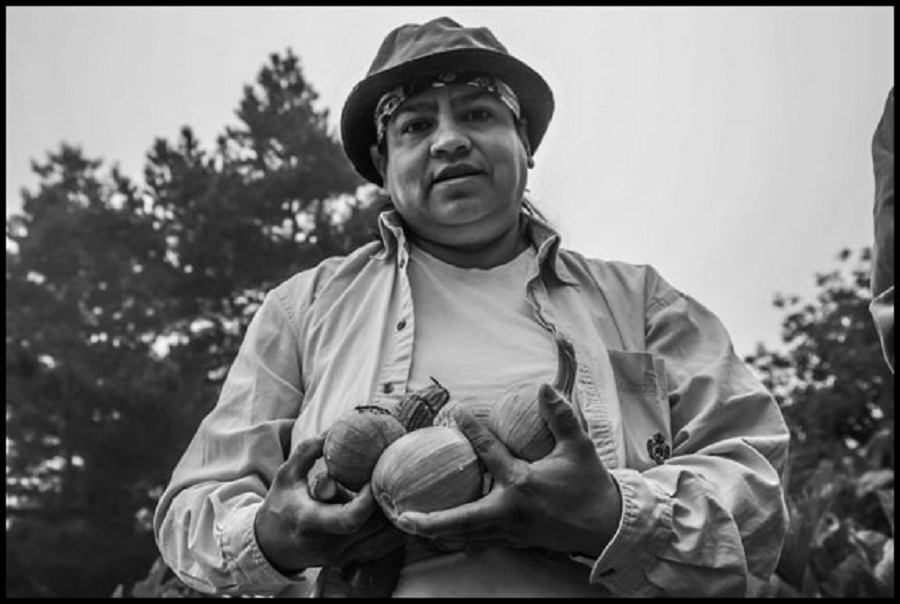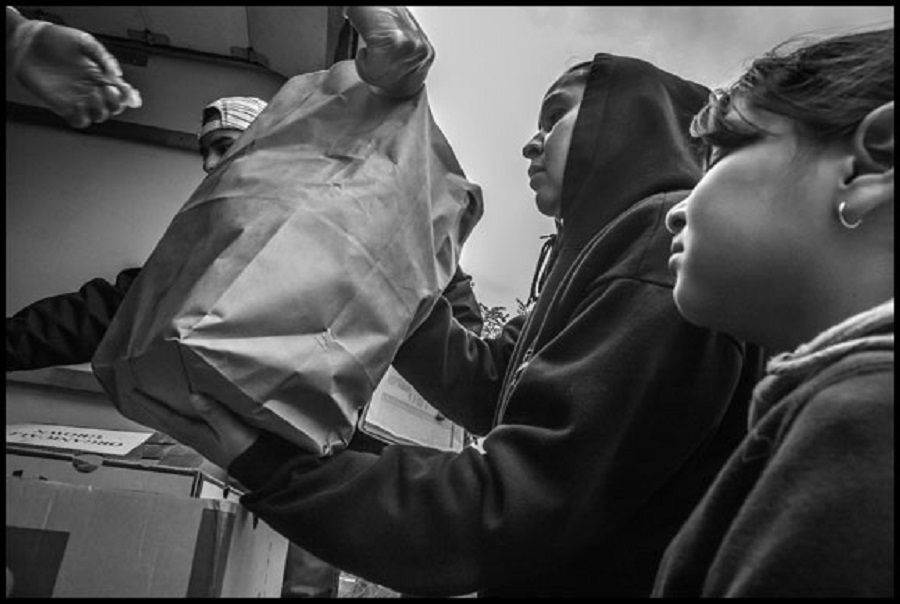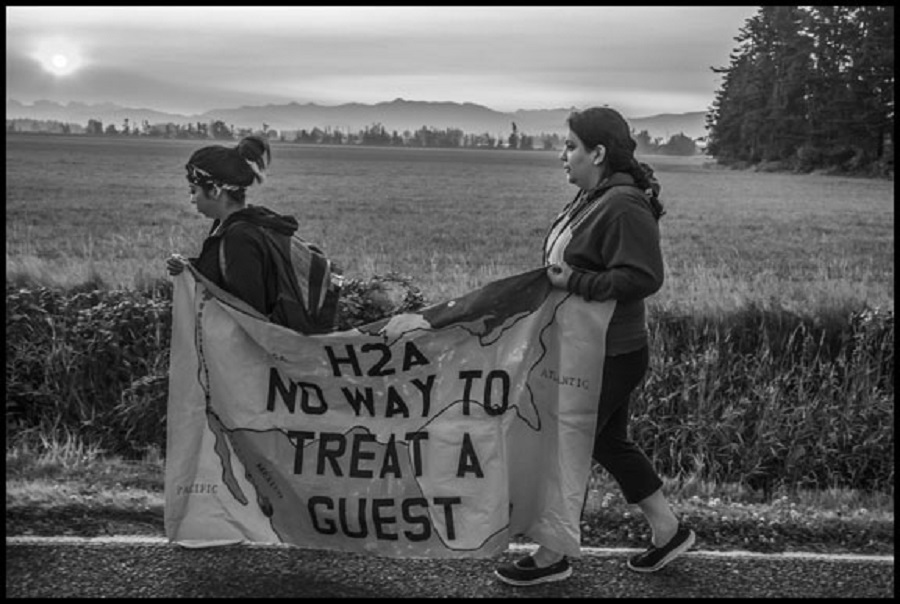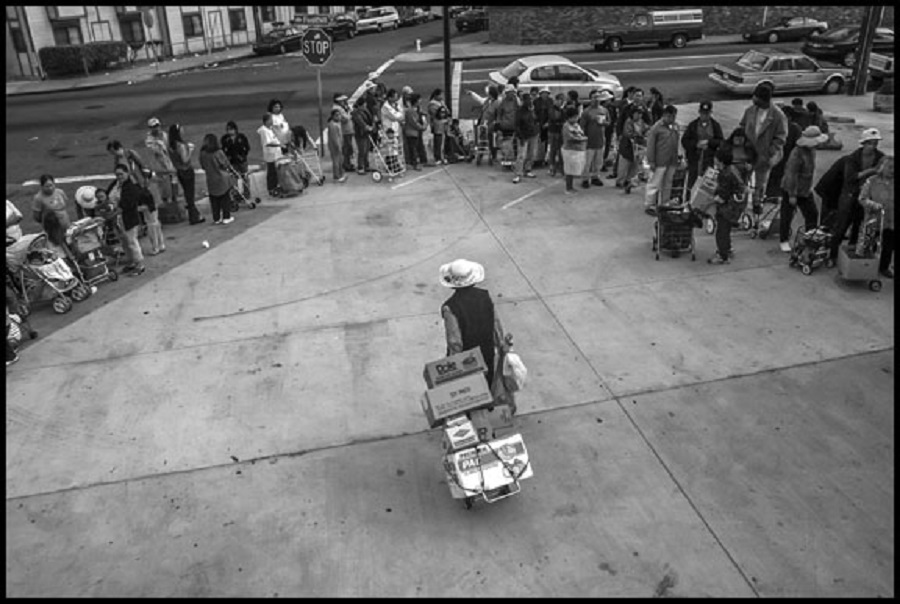By David Bacon
 At the Graton Day Labor Center in Sonoma County, in California’s wine country, immigrant day laborers look for work. At the center workers have a garden, and grow and distribute food to those who are hungry.
At the Graton Day Labor Center in Sonoma County, in California’s wine country, immigrant day laborers look for work. At the center workers have a garden, and grow and distribute food to those who are hungry.
The COVID crisis and urban communities
Malik Yakini speaks for many people in the movements for food sovereignty and sustainability as they face the crisis of the novel coronavirus. He sees it from the perspective of the urban farms of Detroit, as the executive director of the Black Community Food Security Network. «The problems people see now, from the difficulty they’re experiencing getting to markets to the absence of food on the shelves when they get there, really highlight the need for a new food system,» he says.
The city’s urban farmers have had to make immediate changes, just to keep functioning. In Michigan the planting season is just starting, and farmers have yet to figure out how they’ll sell what they intend to grow. «We’ve got collards that we’re just transitioning into the ground now, with green onions, leeks, onions, kale, and soon romaine,» he explains. «To keep everyone safe, we’ve limited the number of people in our farm who can be at work to four at a time, with no volunteers. That’s a big change from the past, when we’d have 15-20 people on a weekend.»
To Yakini, the coronavirus has thrown into high relief the questions that have historically faced the growth of the urban farm system. «Detroit has 139 square miles of land, and a third of it is vacant – more land potentially available than any other city. So one question is how the city will dispose of that part of it that they own, which is managed by the Detroit Land Bank Authority. But it’s really more than just allowing residents to gain ownership. Successful farms have to develop the soil, which is a multi-year project. We need skilled people, and an infrastructure that includes cooling facilities, so that farmers don’t have to sell immediately after harvesting. And the city has to loosen its policies on water use. The need for long-term planning has become much sharper as a result of the crisis we’re experiencing.»
Like Yakini, Karen Washington in New York City sees the crisis as a moment to question the way the food system has failed, especially low-income families and people of color. «We have to acknowledge that we can’t go back, not to business as usual,» she says. «The emphasis has to be on people and planning, not profit. Now we know how valuable food is. What is all your jewelry worth when you have to wait in line to feed your family? But if you can grow food, you can survive. Food and water are more precious than gold.»
Already community activism has changed the way food is being distributed in the Bronx, where Washington lives. In her neighborhood, volunteers from Mothers on the Move and the Mary Mitchell Center deliver bags to older people, who would be vulnerable to infection if they tried to shop for themselves. «Every week I get a delivery of three bags, and then I distribute that food to the seniors I know on my block,» she says. Washington goes across the street to the Garden of Happiness, her community garden, to clean out the chicken coop. She gets a dozen eggs a day that she also gives to elderly people she know are going hungry. «I’ve been on my block for 32 years and I know who’s hungry. That’s what having a community garden means – that we know each other and take care of each other.»
The Bronx has about 150 community gardens in its food chain, and many have been talking in virtual meetings since the crisis started. «We’re asking, what can we grow for our community? In the past we’ve grown for ourselves, and for the farmers markets. Now we’re asking, how we can set aside a growing box specifically for people in the community, and then aggregate the food grown in those boxes together?»
Will the community markets, however, like the one she organized 19 years ago, be able to open when the gardens begin to harvest? «Normally it starts in July, which I hope it will this year. We have a mix of urban and rural farmers who come, but the banks now are putting up barriers to quickly reimbursing them for coupons from SNAP and SMNP nutrition programs. The farmers need money right away and can’t wait for reimbursements. I don’t know if they’ll come to our market this year. We need our elected officials to take action to protect, not just our market, but all the community markets, because together with our gardens, we are a system serving low income people of color.»
In California, Black Earth Farm has developed a system for directly connecting community residents with food. «We used to go to events to distribute our produce, but they all got cancelled when the crisis started,» says jabril kyser, and earth worker at the farm. «But because we met people at those events, they became part of our cultural network and we know who they are.» Black Earth Farm now has a system for online ordering and delivery for some community members. For others, who don’t live in traditional housing, the farm’s members deliver food to them.
«Our community was affected by food apartheid long before the virus arrived,» kyser explains. «So we’ve developed systems in which it can have access to healthy produce outside of the market-based one, which has never met their needs. What’s holding us back now is capacity.» The farm just acquired new acreage in a small city not far from its base in Oakland and Berkeley, and now is planting watermelon and other melons, tomatoes, strawberries, and collards and other leafy vegetables.
«Our work is way more important now,» kyser says, «because we are providing political and agricultural education to our community at a time when the crisis has shown the shortcomings and failures of the industrial food system. Once the crisis has abated, people will still want to grow their own food if we get organized and teach our community how to do it. We can transcend the consumer slavery relations that caused our problems to begin with.»
 Dozens of dairies in California’s Central Valley, in Tulare and Kern Counties, produce milk in industrial conditions. Wages are low and workers complain of injuries caused by pressure to work fast, and mistreatment. Young dairy cows live in cramped stalls in rundown sheds that are so narrow they can hardly turn around.
Dozens of dairies in California’s Central Valley, in Tulare and Kern Counties, produce milk in industrial conditions. Wages are low and workers complain of injuries caused by pressure to work fast, and mistreatment. Young dairy cows live in cramped stalls in rundown sheds that are so narrow they can hardly turn around.
Dumping Milk, Then and Now
Up the Hudson from the Bronx, the coronavirus is having an enormous impact on rural farmers, especially dairies. One of the enduring images of the Great Depression was that of farmers pouring milk into ditches. Today milk dumping, like the facemask, is likely to become a visual icon for the pandemic, particularly in states like New York and Wisconsin where small farmers still depend heavily on milk production.
The dumping of the Depression was often an act of protest, especially during Wisconsin’s milk strike of 1933. Then farmers sought to withhold it from the market to force big distributors to pay a price that might keep banks from foreclosing on farms.
The milk dumping of this past March and April is more an act of desperation. «Some farmers tell me they see the streams running white,» says John Peck, executive director of Family Farm Defenders in Madison. «The price of milk was already down to $12 [per hundredweight], when it takes $20, and $30 for organic, to actually pay what farmers need to survive. We don’t have a fair price in agriculture. Monopolies dictate the price, and farmers have to take it or leave it. Now with the virus, many farmers can’t sell their milk at all.»
Milk dumping is one heart-rending symbol of the pandemic’s impact. Another is the empty refrigerator case in the supermarket, with no milk or eggs on the shelves. «One of the biggest effects of this crisis is that it has torn away the veil on the dysfunction of our food system, and shown how fragile it really is,» explains Jim Goodman, president of the National Family Farm Coalition.
Small farmers were all too familiar with this dysfunction long before the virus began its spread. According to retired New York farmer Liz Henderson, board member of the Agricultural Justice Project, «We’ve had five years of prices that don’t cover costs. Wisconsin alone lost 800 farms last year. This crisis could result in more concentration, with smaller producers bought out by big bigger ones who can stand a few months with reduced or no income. That’s happened to family-run dairies already.»
However, the virus has made vulnerable those farmers who concentrated on direct sales as a way to beat corporate domination of the market. Henderson explains: «We’ve had a big effort over 50 years to campaign for buying locally. If farmers can sell directly, they cut out the middleman. In some New England markets direct sales make up 10% of farm sales, enough for corporations to worry about us. Now, though, if you’re selling to a co-op that bottles and sells to stores, you might be ok. If you sell directly to restaurants or schools, you probably have to dump your milk.»
Could those farmers throwing away their milk instead bring it into the cities to feed hungry people? Karen Washington says yes. «I got a phone call from a farmer last week, asking me how food could be brought into the Bronx. I started asking the city for permission, and got delays and no answers. If we go through the government and the red tape, the food will be wasted. So I said, bring it down, we’re not waiting on red tape. They can put me in jail if they want, but I won’t see people hungry. If the farmers are willing, what are they going to say? Why can’t we use community gardens as drop off centers, to get it out? We’d have to package it, in a way that protects people from COVID, and then the community could distribute it to the people who need it the most.» »
Yakini sees barriers, however, some inherent in the distribution system. «The first challenge would be getting the food into the city, which costs money for farmers who don’t have it. Then, would they be willing to give food away and take a loss? In the past there have been differences in our worldviews here in Michigan, with Detroit versus the rest of the state. In terms of agriculture, large rural farms have not taken urban farms seriously. But we’ve attempted to develop relations with rural farms in the past, and this is a moment when things could change.»
«It hurts people see the milk getting dumped, especially when they can’t feed their children,» Washington responds. «Yet no one said, come to our farm and get it. Why do the farms have to throw it away? Why can’t they open fields to gleaning. If they did, an army of people would get in their vans and go up there. And there are poor people in rural communities who need the food too. Families in rural America are starving. How can they even get to the food if they don’t even have money to put gas in their car? This is all shining a light on the fact our food system has to be changed. What exists is good for a market-based economy, but it’s not good for people.»
 Sandra and Samantha Tello, Mexican farm workers, receive bags of food in the Migrant Labor Camp, a housing project for migrant farm workers in Hollister, California. The food is brought to the camp in a truck from the San Benito County Community Food Bank. Although the families work in the fields picking crops, their income is so low they sometimes don’t have enough food themselves.
Sandra and Samantha Tello, Mexican farm workers, receive bags of food in the Migrant Labor Camp, a housing project for migrant farm workers in Hollister, California. The food is brought to the camp in a truck from the San Benito County Community Food Bank. Although the families work in the fields picking crops, their income is so low they sometimes don’t have enough food themselves.
Small Farmers Get Shafted in the Bailout
Through the Coronavirus Preparedness and Response Supplemental Appropriations Act (HR 6074) and the Coronavirus Aid, Relief, and Economic Security (CARES) Act (HR 748) farmers in trouble were supposed to be able to qualify for small business loans to keep above water. The Families First Coronavirus Response Act (HR 6210) was supposed to help with tax credits.
For small farmers, however, the bills were a bust. «The bailouts aren’t dealing with them,» says Jim Goodman. «Some tried to qualify for the small business loans, but the fund was exhausted by businesses that should never have had access to it, long before farmers could even get their applications processed. Milk prices were already low, and now they’re even lower.»
One example hit the national news when the NY Times revealed that the Ruth’s Chris Steak House chain of high-end restaurants got a $20 million loan and the Potbelly chain $10 million. Shake Shack was so embarrassed by the publicity that it gave back its $10 million, acknowledging that it had access to other capital through an «equity transaction.»
Family farmers with no similar access were pushed out of the line. To Peck «we’re always the last boat on the gravy train. You can talk about the ‘politics of resentment’ but people are angry when they see the fat cats getting all the money.»
Hidden in one bill was a rule (supported by both Republicans and Democrats) that giant chains could qualify for small business loans so long as they had no more than 500 employees per location. The carve-out was the result of a push by the National Restaurant Association, and the chains had their lobbyists at the ready to ensure their applications were first in line as soon as the doors were open. Meanwhile, banks were still trying to figure out how to file applications for farmers, and in some cases, even declined to do so. As a result, 45 percent of the $349 billion in small-business relief went to loans over $1 million, and nearly 70 percent to loans over $350,000.
Beyond the bailout, small farmers, including milk producers, have advocated long-term measures to support higher prices. «Corporations are proposing limited supply management similar to Canada’s,» Peck says. «But we need a better one. For farmers the most important things are guaranteeing a fair price, restricting imports, prohibiting dumping, and labeling products with their place of origin. The distributors don’t want any of that.»
Large producers organizations, like the National Milk Producers Federation and the National Farm Bureau, also want a $16 cap on prices to farmers. «That won’t cut it for most family dairies,» Goodman says. «To help farmers we have to make them whole, long term. Instead I’m afraid the next plan will have nothing for us. The Progressive Caucus and people like Tammy Baldwin and Ro Khanna are willing to promote bailouts to help farmers, and at the same time get good food to urban people. But the number of people who listen to us is small.»
In the meantime, small farmers and rural communities are faced with surviving the virus itself. Wisconsin already has it in every county. According to Peck, «the average age of farmers is pretty old, which makes us a vulnerable population. Some farmers now just send their kids to the farmers’ markets. We’re already sheltering in place a lot during normal times, but now our cultural fabric is being disrupted. We have no church, and people in isolated communities depend on personal connection. That isn’t easy when the opportunities are gone.»
Farmers are scared, he says. «In lots of rural areas we have no healthcare. Some places have even put up signs saying, ‘Snowbirds – don’t come back this year. You will overwhelm our little clinic.'» That fear, however, also makes many farmers advocates of universal healthcare. The biggest cause of farm bankruptcies are health crises.
Another reason for fear is the lack of easy communication that urban areas take for granted. Governments close schools to avoid spreading infection, but then tell families to have students continue their studies online. «But we live in a broadband desert,» Peck explains. «20-30% of rural Wisconsin has no internet at all. Parents have to drive 20 miles, and sit in their car with their kids in the parking lot of the public library so they can connect to their teacher. This crisis is really revealing the impact of the digital divide. You can see that broadband should be a public utility, since everyone needs it.»
 Hungry families gather in Orange Grove, California, to hear state officials explain how food would be distributed. Mexican farmworker families had no work because a freeze caused the loss of the orange crop. Workers had no unemployment benefits or relief because most have no legal immigration status.
Hungry families gather in Orange Grove, California, to hear state officials explain how food would be distributed. Mexican farmworker families had no work because a freeze caused the loss of the orange crop. Workers had no unemployment benefits or relief because most have no legal immigration status.
A Moment of Opportunity
Disaster brings change, however. Many grassroots organizations and movements are trying to seize the moment to propose alternatives, and in some cases, to begin implementing them. Some are breathing new life into proposals made before the COVID-19 crisis began.
In her writing prior to the pandemic, Dr. Katia Aviles Vasquez pointed to the impact of earlier economic and physical disasters in opening doors to change in Puerto Rico. «After the earthquakes of 2020,» she noted, «while small scale farms have continued to produce and even served as shelter to affected families, large agri-businesses are losing crops due to lack of local labor as a result of migration and displacement. In the midst of all this devastation and suffering, a new PR is rising. The hurricanes laid bare the vulnerability of the islands to climate change and the inability of the government to respond. The hurricanes also laid bare the communal culture that US colonialism could not eliminate. People organized mutual support centers in their communities to generate endogenous alternatives for self-sufficiency.»
Aviles Vasquez pointed to the importance of reconnecting communities to elements of culture that help people survive. «Our culture and traditions have been our means of resistance to colonialism,» she wrote. «Root crops and legumes, Puerto Rican diet staples before industrialization, were critical in post-Maria [hurricane] survival and are regaining popularity as new recipes combine traditional cuisine with innovative flavors. A new cadre of young agroecological farmers, educators, chefs and entrepreneurs are working toward a more just and regenerative food system.»
Aviles vision is becoming a reality, as the community-based food system of Puerto Rico responds successfully to the COVID-19 crisis, while the corporate system flounders and fails. According to Magha Garcia, a farmer and president of the Organizacion Boricua, «the small agroecological farms on the island, and the corner and cooperative markets, already had a close relationship with the consumers of what they grow. They knew each other. That was the key.»
The first two weeks after Puerto Rico’s governor issued an executive order, closing non-essential businesses and ordering people to shelter in place, was nevertheless very difficult for the farmers. The order didn’t have an explicit exception that allowed farmers to travel with their products, and the police intervened to stop them on the roads. «Many organizations, including the Cooperativa Madre Tierra and the Organizacion Boricua, wrote a letter, declaring that small farmers had a right to function,» Garcia recalls. «And there was some acknowledgement of the fact that farmers needed to distribute and sell the food, and the people needed it. But we had to find a new system that didn’t expose anyone to the virus.»
Travel has continued to be difficult. Police stopped the vehicles of timoneros, who bring oxen from farm to farm to plough the land for planting. «We had to defend the right of rural people to be on the road,» Garcia says. Other problems had to be overcome as well. Because of Puerto Rico’s colonial economy, all the protective equipment on the island – gloves, masks, gel – comes from the U.S., and the U.S. government halted shipments. «Sometimes we’re part of the U.S., when it’s convenient for them, and sometimes we’re not,» Garcia laughs bitterly. «But we got on the internet and found venders, and people made their own masks.»
With the help of students, the Organizacion Boricua put together an infogram and educational materials for farmers that explained the importance of washing hands, and how to clean shoes and maintain physical distance. While the majority of farmers have internet access, there are remote parts of the island where the damage from Hurricane Maria and the following earthquake have keep communities isolated, without power. Those areas, however, have developed mutual support centers whose members then knocked on doors to explain things to residents in person.
A system developed quickly, based on direct communication between small agroecological farmers, cooperatives like Madre Tierra, and consumers themselves. The system established in Puerto Rico resembles in some ways the one being developed in Oakland by Black Earth Farms. «On the internet, consumers now can order a box of food, which the farmers will put together,» Garcia explains. «Then the consumers will go to a pre-arranged spot to pick up the box. They can pay on the internet, or if they only have cash, they have to put it into a sealed envelope, which is the wiped with sanitizing gel. After we presented evidence of the need, and that this would protect people, the police had to accept it.»
People called the boxes «surprise boxes» because they didn’t know exactly what they would get. And there was another surprise as well. «Small agroecological farmers didn’t suffer a reduction in their market. Once they were allowed to function and the government order was clarified, their market grew,» she says. «People who hadn’t come to the corner markets or to the Cooperativa Madre Tierra and other coops before began using this system too. Going to supermarkets is really a problem for most people. You spend a whole day because the lines are so long. Using this alternative system is easier.
«When we get past this crisis, our next problem will be how to keep these new people. But there are a lot of folks in Puerto Rico with health problems – diabetes, cancer and a compromised immune system. Getting the box is a safe alternative for them that minimizes risk, and it’s healthier food.»
It has been a chance for this alternative system to prove its value. «Conventional farmers lost their crop because they lost their market when restaurants closed and the distribution chains broke down,» Garcia explains. «Puerto Rico still gets most of its food from outside, so the supply problems meant the supermarkets didn’t have food on the shelves. Prices went up for what they did have. Plus, who knows who’s been touching that product or where it comes from. People are wary of it.
«The small agroecological farmers had new costs, but they could function when the other system couldn’t. Now even conventional farmers are starting to copy this new system. In the middle of this crisis we’ve seen an answer we didn’t expect. We thought we would be losing a crop, and instead we grew.»
 Farm workers and their supporters march to protest the death of Honesto Silva, on the anniversary of his death a year earlier. Honesto Silva was a guestworker recruited to work at Sarbanand Farms, who died because of excessive heat and pressure by the company to keep working. The march was organized by Community2Community and the new union for Washington farm workers, Familias Unidas por la Justicia.
Farm workers and their supporters march to protest the death of Honesto Silva, on the anniversary of his death a year earlier. Honesto Silva was a guestworker recruited to work at Sarbanand Farms, who died because of excessive heat and pressure by the company to keep working. The march was organized by Community2Community and the new union for Washington farm workers, Familias Unidas por la Justicia.
Farmworkers in the COVID crisis
Other community-based alternatives revolve around fighting for the welfare of workers in the food supply chain. For many years Community2Community and Washington state’s new union for farmworkers, Familias Unidas por la Justicia, have warned that growers are increasing the recruitment of guest workers in the H-2A visa program, endangering both guest workers themselves and local farmworkers.
As the COVID-19 crisis began, earlier in Washington than other states, C2C called on the state’s governor to enact emergency orders with funding to ensure that all protective measures were taken. For H-2A workers the dangers start with a total lack of testing for the virus as they enter the country, as well as during the period of their contract employment. Many are not aware of the health crisis that has engulfed their destination communities. And since they must return to Mexico or other countries at the end of their work contract, COVID-19 contracted in the U.S. can then spread there.
«In addition to informing workers about the terms and conditions of employment when they are being hired,» C2C said, «people recruiting for agricultural employment in Washington must provide detailed information about the risks of COVID-19, including how employers will protect their safety while transporting and housing them, and in the workplace … There must be designated sanitized quarantine living facilities with access to medical personnel.»
Farmworkers are forced to work in close proximity and share close living and eating quarters, as well as when they’re taken to and from work in vans and buses, in large groups. «The current protocols are not enforceable and have huge gaps, giving individual corporate farms loopholes,» C2C charged. «This has potentially deadly consequences for farmworkers and rural communities that are already underserved.»
When the state did not take the measures advocates were seeking, C2C then joined Washington’s two farm labor unions, Familias Unidas por la Justicia and the United Farm Workers, along with Columbian Legal Services, and filed suit. They seek to force Washington’s Department of Health and Labor & Industries to come up with mandatory measures growers must take to protect workers, in place of voluntary «guidelines.»
The need for stricter oversight of the H-2A program became even clearer when the Trump administration announced that, although it was closing off all channels for legal immigration to the U.S., it was making an exception for H-2A guest workers. Trump told growers «I know you have to have them.» The program has expanded from 50,000 grower applications to 250,000 since 2014, and Congressional and administration proposals would undermine its weak labor protections even further. Battles over the expansion of the program, regulations to cut workers wages, and bills in Congress to make it even more grower-friendly, will outlast the virus crisis.
«The increase in growers’ use of the H-2A guest worker program,» says C2C director Rosalinda Guillen, «has had a huge impact on working conditions in the fields. We’ve had to feed guest workers who come to us hungry, fight to get them paid their wages, and help them deal with extreme work requirements. At the same time, our local workers find they’re not being hired for jobs they’ve done for many seasons.
«In the capitalist system we are disposable and easily replaceable, and the guest worker program is a good example. You bring people in and ship em out and make money off of them. It’s time to end that. We’re human beings and we’re part of the community. We have to be the first ones to speak out because we’re the first ones to die. The average lifespan of a farmworker was 49 years even before the virus, just two years up from what it was in year 2000.»
 Hungry people wait for food at a food pantry run by volunteers from Project Help in the parking lot of a laundromat in East Oakland, California.
Hungry people wait for food at a food pantry run by volunteers from Project Help in the parking lot of a laundromat in East Oakland, California.
The Political Opening
Henderson points out, however, that the rules of political conflict are being changed by political openings the pandemic has created. «The discombobulation of the supply chain is being revealed, which makes direct sales so important, whether to consumers or to farmers themselves. We need to take the things we’re learning, and instead of trying to put things back the way they were, we should move forward, strengthening family-scale farms, farmworkers and food coops.»
Peck agrees: «The COVID-19 crisis has clearly shown the inherent weaknesses and fundamental injustices of our corporatized, globalized, industrialized food/farm system. But it has also revealed the path we need to take towards a more equitable and sustainable one. We need to rediscover and reinvigorate the mutual aid ties and solidarity relationships that are already found within our diverse communities.
» Second Harvest in Wisconsin, for instance, allocated a million dollars to buy milk to help farmers, and because they’ve had a 60% increase in food bank visits. That’s something the government should be doing. Why don’t they earmark $300 million to buy products being thrown away, give them to hungry people and give the bill to the corporations?»
Can the system afford it? «There’s lots of money in the food system,» Henderson believes. «If we could take the billions of the Waltons and Jeff Bezos and redistribute them more fairly, we could pay workers a decent wage.»
All these activists agree: lack of access has never been about a lack of food. «It’s a problem of distribution,» says the National Family Farm Coalition, «with people of color and tribal nations across all sectors impacted disproportionately. As the pandemic threatens to strip even more families of their income, more will be unable to afford healthy, safe and nutritious food in the near future.»
To meet this threat, the Coalition and other food sovereignty advocates have given a set of demands to Congress for any future stimulus package. It includes making people of color in the food system central to demands, ensuring a fair livelihood for everyone in it, strengthening local systems, protecting small and medium size farmers and fishing operations from predatory banks and corporations, and ensuring a dignified way to obtain nutritious food for every person in the country.
Patti Naylor, a board member of Family Farm Defenders in Iowa, writes, «Farmers support agroecology because it recognizes the interdependencies between rural communities, local ecosystems, and healthy competitive economies. Agroecology offers an inspiring alternative to the industrial agriculture model that is failing rural communities. However it cannot thrive without the political support that agribusiness currently receives. U.S. agriculture policy needs to prioritize agroecology and ensure farmers’ rights to seeds, safe water, and pricing structures that ensure farm viability.»
The NFFC’s Goodman concludes: «We are seeing how fragile our food system is, with the globalization and concentration of production, and a few huge processing plants. We have to go back to regional and local food systems. The pandemic can be a driver to change this. In times of crisis people are more willing to look to the government for help. What has to happen is that the government must step in. What happens to farmers and farmworkers has to have the same level of importance as fair wages or climate change. With the pandemic, we have to think about changing the policies for when we come out on the other side.»
 Willie Mills drives a truck from community to community, setting up food distributions to impoverished families living near the border fence between the U.S. and Mexico, in the desert in Eastern San Diego County.
Willie Mills drives a truck from community to community, setting up food distributions to impoverished families living near the border fence between the U.S. and Mexico, in the desert in Eastern San Diego County.
Entre Noticias | Reality Check | evr







